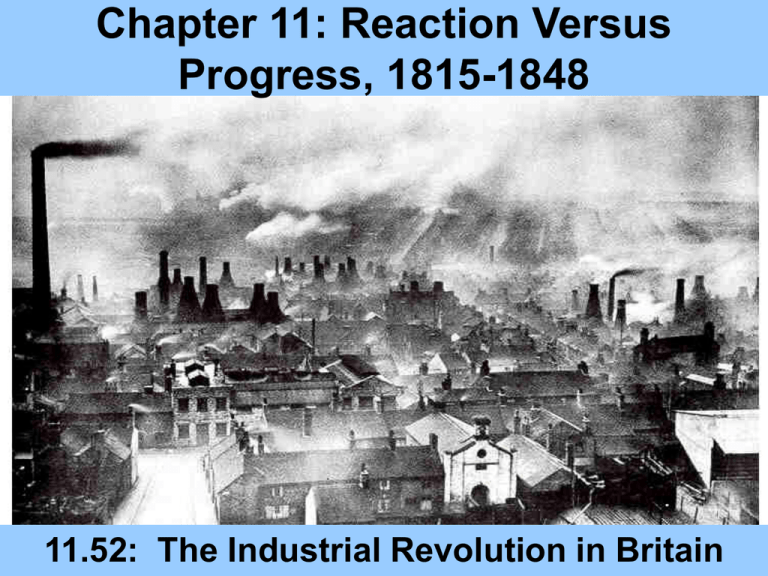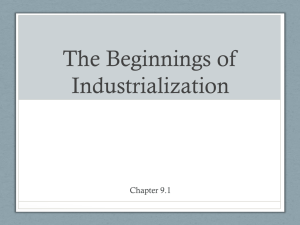Chapter 11: Reaction Versus Progress, 1815-1848
advertisement

Chapter 11: Reaction Versus Progress, 1815-1848 11.52: The Industrial Revolution in Britain Today’s Agenda • Collect Homework • Return and go over Quiz • 11.52 slide show Industrial Revolution Treaty of Paris end 7 Years’ War 1763 1769 James Watt invents Steam Engine Hargreave’s invents Spinning Jenny (1765) List’s National System of Political Economy -Mines Act (1842) Industrial Revolution Begins Luddites Revolt 1775 1780 Population explosion begins in GB American Revolution Begins 1798 1812 Malthus, Essay on the Principle of Population 1830 Industrial Rev. begins on Continent (1815) Great Exhibition in Crystal Palace 1841 1851 Factory Act (1833) Why did it begin in Great Britain? • Atlantic Economy – Vast colonial empire (raw materials, markets) – Controlled slave trade (colonial labor) • Geography – No part of GB further than 20 miles from H2O – Canal network enhanced water transportation (after 1770s) • Natural Resources – Iron & coal deposits • No internal tariffs • Agriculture Revolution – Low prices for food – More disposable income • Strong Central Bank and Credit • Stable government • Laissez Faire – Allowed for innovation, person initiative • Large mobile labor force – Enclosure acts The Industrial Revolution In Britain • Work was done with hand tools until 1800 Industrial Revolution is the process of shifting from hand labor to machine labor Shift occurred gradually (and is still occurring) What brings about this change? • • • – IE.People are by nature conservative • – Government • – Soviet government was form of state pressure (motivating force) to mobilize population Mobile population is important prerequisite for industrialization • – don’t just alter their lives, where they live, ect. Without a strong motivator. Britain experienced a long trend of moving toward a mobile labor class Agricultural base The Agricultural Revolution in Britain • • • • • • • • Landowners were in control of Parliament push for experiments in agriculture which reduced labor demands Population density required most efficient farming Adopted enclosure, crop rotation, heavy manuring by mid 1600s Urban growth offered markets to farmers English learned about swamp drainage Jethrow Tull – Advocated drilling seed – Better husbandry of horses By 1870 English farmer produced 300% more than 1700 The Agricultural Revolution in Britain • Enclosure Acts (18th and 19th Centuries) – joining the strips of the open fields to make larger compact units of land. These units were then fenced or hedged off from the next person's land. In this way a farmer had land in one farm, rather than in scattered strips. – Between 1760 and 1780, some 900 Enclosure acts were passed – farmers enclose land in order to produce a greater amount, thereby earning bigger profits. Also, where land was enclosed, landlords could charge tenants higher rents • ending the commons and communal cultivation • Fencing in large tracts of land (fences, walls, hedges) • More efficient, more productive • yielded more meat, cereals • food supply increased with smaller % of the population needed • Freed labor and created a more mobile class of workers Industrialization in Britain: Incentives and Inventions • • • • • • England had new colonial markets, control of seas Profit, Profit, Profit fueled the search for more rapid methods of production – Ie. Woolen had been a staple export – but more production possibilities were limited Cotton held huge possibilities Wealthy land owners (from enclosure) could afford to divert some profits to experimenting with industry Only a country already wealthy from commerce and agriculture could have been the first to initiate the machine age Wealth from commercial activity fueled the growth of industrialism in England First Factories • Cottage Industry • Plagued by constant thread shortages • James Hargreaves – Invented cotton spinning jenny (1765 Inventions in textiles • • • • • flying shuttle • John Kay in 1733 made machine that required 1 not 2 to weave cloth on loom • created strong demand for yarn spinning jenny – invented in 1760s allowed yarn production to increase – James Hagreaves (hand powered) – Richard Arkwright in 1769 harnessed water power to operate jennies – A female dominated job – jennies overwhelmed loomers with yarn Took place in mill (factory) near water source power looms allowed them to catch up – this production put a strain on supply of raw cotton cotton gin – Eli Whitney was a Conn tutor on plantation in Georgia in 1790 – 1820 it makes up half of British exports (cotton textiles) The ‘water frame’ for spinning cotton, designed by British inventor Richard Arkwright in 1768. Although so-called because it was water-powered, it was originally driven by mule. From 1790 onwards it was powered by steam engine. Its increased efficiency allowed Arkwright's factories to successfully compete with Indian calico manufacturers. Early Factory Workers • Orphaned or abandoned children • Parish officers “apprenticed” them out • 5-6 years of age • Food, shelter, “schooling” provided • 14 hour days with no pay • Brutal discipline • Robert Owens Testimony (see page 746) Other Innovations Steam • Alternative source of power was needed • Medieval forests were depleted • because of a lack of hydropower (started to experiment with steam power in 1700s) • Coal used to heat homes since 1640 – • • • • English inventor Thomas Newcomen built the first successful steam engine in 1712. It was used to pump water out of mines. coal difficult to get because of deep shafts filled with water Thomas Newcomen 1705 coal mine pump engine (a coal guzzler) James Watt of Un. Of Glascow 1763 more efficient engine for factories Still engines were quite cumbersome and stationary only 1807 Fulton 1800 created a steam boat on Hudson from Bolton and Watt engine BBC - History 'Stephenson's Rocket' Animation Railroads • Horse/canals had been used for heavy freight – Slow, expensive, limited market potential • Rails had been used in mines to reduce friction • George Stephenson 1829 – Created the “Rocket” locomotive on Liverpool and Manchester Railway that only reached 16 mph • Significance – – – – Reduced cost of shipping Broadened markets Encouraged larger factories Workers who built RR usually settled in city and became factory workers • Factory system – England is still rural but factory system (especially in textiles) is growing by 1780 Joseph MW Turner (1775-1851) Some Social Consequences of Industrialism in Britain • • Changes in population Grew from 10 mil in 1750 to 30 mil in 1850 (England and Ireland) Change in Location • used to be concentrated in southern England • with coal and iron in Midlands and north new cities rose Change in Growth (urbanization) • 1785 only 3 cites had 50 thou or more • 1845 31 this size Manchester • 1772 25,000 by 1851 455,000 • No legal status (had no legal method of incorporating cities until 1835) • This created problems providing public services to rapidly growing urbanization • Dirty, dark, sooty, drab, cloudy climate anyway • Tenements, entire families in 1 room, swarming with ragged children (who had nicknames only) • Factories only needed unskilled laborers • Unskilled labor devalued former trades people • Child labor- work so mechanical that children as young as 6 worked • Women • 14 hour work days of tedious regimented conditions • very few holidays except layoffs were often • workers had little in common and were not unionized • • • • • • • • Cotton Lords first industrialists often self-made, intelligent not ostentatious hard working thought that landed gentlemen were idlers and poor lazy believed that they did poor a favor by hiring them detested public regulation of their business 1802 Factory Act tried to regulate conditions of pauper children in textiles by England had to class of trained, paid administrators to check conscientious and independent TABLE 4 STARTING AGE OF WORK IN COTTON MILLS (Manchester cotton workers starting work 1816-18) ages males (%) females (%) 10 & under 70.8 39.3 11-13 17.8 17.3 14-19 5.8 24.2 20-29 3.6 14.7 30 & over 2.0 4.5 # of obs 445 491 Source: Lords Report (1818, 1819, appendices). Classical Economics: Laissez-Faire Manchester School • Economic philosophy of Thomas R. Malthus and David Ricardo (both were Adam Smith followers) • Free hand of the market and free trade (Smith) • in free market regulation comes from natural laws (law of supply and demand, diminishing returns) • all people should follow their own enlightened self interests which will generate general welfare and liberty of all • govs job is to preserve security of life and property (reasonable laws, reliable courts) • no tariffs • Population growth (Malthus) & Iron law of wages (Ricardo) – when workers earn more than subsistence wage they breed more children who eat up the excess and reduce working class to subsistence level Thomas R. Malthus Experiences of the workers • • • • • • • Hard labor was not new Concentration of labor made needs of labor more evident in cities workers obtained more knowledge of world and developed a sense of solidarity (led to collective bargaining) Britain was unchallenged in for most of a century began to “export” capital London became the world’s financial clearing house A Punch cartoon of 1844 entitled Capital and Labour contrasts the luxurious life of a mineowner with the harsh working conditions in the pits. Although the Industrial Revolution brought Britain as a whole greater material prosperity, it also caused massive social upheavals




